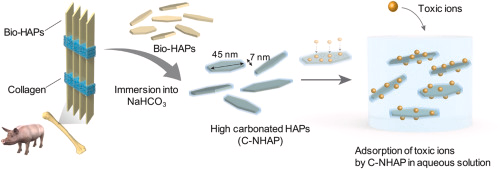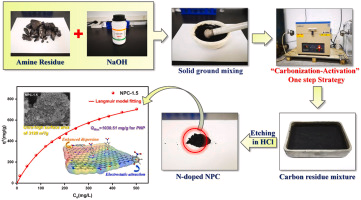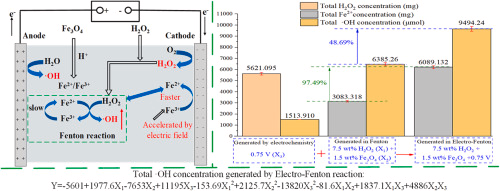


JAEA:骨头吸收锶:开发出高度碳酸化的磷灰石
日本原子能机构:
东京大学:
该研究小组于2月4日宣布,已开发出一种廉价且高效的由废猪骨制成的金属吸附剂。
“碳酸有助于骨骼吸收锶等金属。”
食物垃圾的利用:
将餐厨垃圾的猪骨节浸泡在家用小苏打水溶液(碳酸氢钠)中。
创建,分析和开发了“高度碳酸化的磷灰石”。
核工业报纸
https://www.jaif.or.jp/journal/japan/6461.html
废猪骨成为有害的金属吸附剂
-实现新的金属吸附技术-
我们已经开发了一种利用废料的廉价,高性能的金属吸附技术。
利用猪骨晚宴:
实验是使用猪排骨和小苏打(碳酸氢钠)进行的,该猪排是一种食物残渣,小苏打也可以用作食物添加剂。
猪骨加压加热后
当浸入含有小苏打的水溶液中时,
确认形成了白色结构,可以保持骨骼的形状(图1)。
结构组成和微观结构分析:
研究了该结构的组成和微观结构。
事实证明,它是由纳米碳酸盐磷灰石晶体组成的。
这种碳酸磷灰石比正常骨骼含有更多的碳酸。
碳酸磷灰石晶体:
增加要浸泡的小苏打水溶液的浓度会增加碳酸的量。
换句话说,发现“当浸入小苏打中时,形成了含有大量碳酸的含高碳酸的磷灰石”。
锶吸附性能分析:
将所制备的碳酸盐磷灰石在锶水溶液(浓度为0.1 mol / L)中搅拌。
之后,测量溶液中残留的锶以研究锶的吸附性能。
锶吸附评估:
碳酸磷灰石在3分钟内吸附了溶液中99%的锶。
对吸附性能进行了更详细的研究。
碳酸盐磷灰石的分配系数Kd值[5]为274,780 mL / g。
它是未经处理的骨头的250倍(图2,左)。
镉和铅的吸附性能:
我们还研究了碳酸盐磷灰石对镉和铅的吸附性能。
结果,发现“碳酸磷灰石高效地吸附镉和铅”。
[前景]
用厨余里的猪骨头
在一个简单的过程中,
具有高性能的重金属吸附性能,
我们已经成功开发了吸附剂。
除了净化受污染的水外,这种材料还可以嵌入土壤中,以防止污染物扩散到环境中,例如地下水。
解决环境污染问题的对策:
预期将其用于最大化人类摄入有害金属的可能性。
此外,期望“用作用于回收有用金属的吸附剂”。
与这项成就有关的日本和海外专利正在申请中。
日本原子能机构:新闻稿
https://www.jaea.go.jp/02/press2020/p21020401/
Carbonated nanohydroxyapatite from bone waste and its potential as a super adsorbent for removal of toxic ions
Abstract
The effective, low-cost decontamination of toxic metals
is critical for addressing global health risks, reducing environmental pollution, and building a sustainable future.
Here, we developed
an eco-friendly hydroxyapatite nanocrystal adsorbent made from bone waste that can effectively capture 90Sr.
Highly carbonated nanohydroxyapatite (C-NHAP) crystals with a negatively charged surface
were obtained by simply immersing pig bone in an aqueous solution of sodium hydrogen carbonate (NaHCO3).
Fourier transform infrared spectra showed that
the C-NHAP was highly carbonated and that the amount of introduced carbonate ions (CO32−) increased with increasing NaHCO3 concentration in the immersion solution.
With increasing amount of CO32− ions introduced into the C-NHAP, it exhibited a greater ion-adsorption performance. The distribution coefficient (Kd = 24,780 mL g−1) of the C-NHAP for Sr2+ was approximately 20 and 250 times greater than those of clinoptilolite and untreated bone, respectively.
The C-NHAP also exhibited high adsorption capacity (Qe = 125 mg g−1) for Sr2+.
The extended X-ray absorption fine structure spectra
showed that the CO32− sites in C-NHAP played an important role in its high adsorption performance.
The C-NHAP exhibited high adsorptivity for Cd2+, Pb2+, and Cu2+.
The C-NHAP prepared from bone waste
is an eco-friendly, high-performance, low-cost material that should be useful in environmental pollutant removal and food waste disposal.
ScienceDirect
https://www.sciencedirect.com/science/article/abs/pii/S2213343721000920